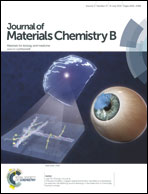Microwave-assisted synthesis of hemin–graphene/poly(3,4-ethylenedioxythiophene) nanocomposite for a biomimetic hydrogen peroxide biosensor†
Abstract
The large-scale synthesis of ternary nanocomposite hemin–graphene sheets/poly(3,4-ethylenedioxythiophene) (H–GNs/PEDOT) was achieved via a microwave-assisted method, in which PEDOT was polymerized with graphene oxide and induced with hemin on the H–GNs nanosheets without additional oxidants; meanwhile, graphene oxide was partially reduced simultaneously. The morphology and structure of the as-prepared nanocomposites were characterized by transmission electron microscopy, Fourier-transform infrared spectroscopy, and ultraviolet-visible absorption spectroscopy. The H–GNs/PEDOT nanocomposite combines the main excellent properties of the three components, maintaining the peroxidase-like activity of hemin, and displaying a high-speed electron transfer ascribed to the presence of PEDOT and the graphene sheets. The H–GNs/PEDOT exhibited remarkable electrocatalysis towards the reduction of H2O2 due to the direct electron-transfer between the hemin and the modified electrode. The excellent synergic effect enables an enhanced electrochemical performance of the H–GNs/PEDOT modified electrode with good biocompatibility and fast redox property. The novel biomimetic H2O2 biosensor based on the well-designed ternary hybrid H–GNs/PEDOT has a low detection limit (0.08 μM) with a high dynamic response range (10−7 to 10−5 M) and a high sensitivity (235 μA mM−1 cm−2). The sensor displays good selectivity, repeatability, reproducibility and stability.


 Please wait while we load your content...
Please wait while we load your content...